How to Get Rid of Sugar Ants: Tips & Exterminator Quotes
We put together a detailed guide on how to get rid of sugar ants. We included DIY methods as well as 4 free exterminator quotes.
When sugar ants attack your kitchen, you know you are in trouble. These small pesky insects can be a nightmare in your home, not to mention annoying and a nuisance. Once sugar ants invade your home, getting rid of them is never a simple task. Even after you have cleaned every corner of your kitchen, somehow you will miss a few particles of sugar, or maple syrup or a few scraps of food. A few minutes later, you will find hundreds of these tiny pesky insects lined up in your kitchen floor crowding and carrying the small particles of whatever is on the floor on a back and forth match to their nests.
Well, the word sugar here might be misleading a bit. The real sugar ants commonly known as banded sugar ants is a species of ant found in Australia, and it’s particularly known to be attracted to sugar. Most likely, the ants you see in your kitchen are pharaoh ants or pavement ants. But since most people know them as sugar ants, we will refer to both of these ants as sugar ants for simplicity purposes. Besides, the ant’s species have the same characteristics and require same removal methods.
Sugar ants, get their name from their eating habits. But, anything that is sweet is their main attraction. Their diet includes sugary and sweet food sources, greasy leftover foods and any scraps of food they find lying around in your kitchen. They are likely to invade your home early in spring and fall when they are foraging for food and to look for dark, moist and cool places to nest and build their colonies.
If your home offers the ideal living conditions which include, food, and water, sugar ants will become your uninvited guests. They can be found anywhere including urban areas, in the wooded areas, deep in the forest and in shrublands. Sugar ant’s nests can found beneath the roots of trees, old or decaying wood, around twigs of trees, in bushes, beneath soil or underneath rocks.
In fact, it’s quite easy to identify sugar ant’s nests. Their homes resemble small mounds and usually have a small hole on top that looks like a tiny hill. Below their nests, you will find small paths that ants use to get to their source of food and back to ensure that their queen is well fed to breed more ants.
Even though they can bite, they do not sting; thus, sugar ants are actually not dangerous to humans. But, these tiny insects are a nuisance when they infest your home. They can chew through cardboard, paper and even through plastic containers and contaminate the contents inside. Their presence in your home may end up attracting other pests like spiders, rats, and even centipedes
How Do Sugar Ants Look Like?
Sugar ants are small sized insects that measure between 2 to 15 millimeters when fully grown and the queen ants can even be larger. The male ones are, winged, and completely black while the female sugar ants have a black head and orange colored body. Their bodies are segmented into three parts; head, thorax, and abdomen. They have a small waist that connects the thorax and abdomen and three legs attached to each side of their thorax. Their antennae, located at the top of their head, appears noticeably bend.
Sugar ants are omnivorous meaning they can basically feed on anything from plants, to insects and rotten food. But their main attraction is sweet foodstuffs especially nectar. Even though they are nocturnal, you are likely to see them during daytime especially when its warm and damp. But, you will hardly spot sugar ants during winter.
Signs of Sugar Ant’s Infestation
Once in a while, you might start noticing small ants lining up in your kitchen and crowding around on fallen food scraps on the floor. A few sightings might not be an indication of an infestation. However, if the sightings become more regular, almost everywhere in your house, you could be having sugar ant’s problem.
The sugar ant workers will most come out at night to forage for food. You are likely to find them in your kitchen where there is plenty of food. Since they are attracted to scraps of food, spills, and stains, the first place you should pay close attention to is in the pantry and below the kitchen sink. If you find a pile of sugar ants in these two places in large numbers, it’s possible they are nesting in your home or close by.
Sugar ants are nocturnal insects, and it might actually be hard to notice that you have an infestation. The workers normally come out at dusk and you will see them moving on the floor or corners of your house following a trail when searching for food. Due to their nocturnal nature, it would be hard to locate their nests.
If you have spots in your home that are dark, cool and moist, they should be the first place to look for sugar ant’s nests. If sugar ants infest your home, they will build their colonies in areas with such conditions. More so, if you have an older home, you are more likely to attract sugar ants since such homes have moist, dark and cool areas, that attract sugar and provide ideal hiding spots.
How Do Sugar Ants Get to Your Home?
Sugar ants have strong receptors, actually four to five time stronger than other insects. When they are searching for food, sugar ants can smell the presence of food from miles away. Even a small spill or traces of food scraps left on the floor or countertops can be enough to attract a whole trail of sugar ants into your home.
Trash bins full of filth, dirty sinks and floors also attract sugar ants. Dirty dishes left on the sinks also lure sugar ants into your kitchen. Sticky sugar stuff and snacks left in open containers, flour, sugar, bread and other baked foods left in the open will bring sugar ants in large numbers into your home. Other sweet foodstuffs like molasses products, honey, maple syrup, sodas, juices among others are also sources of food for sugar ants.
The bottom line is, sugar ants will come to your home and nest if there is plenty of food sources and ideal conditions to build their colonies. Dark, cool and moist areas in your home are ideal places that attract sugar ants into your home. Dark places are much easier for sugar ants to get into, build their nests and colonies without human interferences. If you notice a trail of sugar ants in your home and small clusters of ant’s all over your house, you could be dealing with an infestation. If you are sighting trails of sugar ants even during the day, it’s time to take action and get rid of them before the infestation grows to massive colonies.
How to Get Rid of Sugar Ants
If sugar ants have invaded your home, you need to get rid of them. Sugar ants can contaminate your food, spread all over your house and become a nuisance. Having ant’s all over your house can be unsettling. Once you discover that you have sugar ants in your home, you need to figure out how they are gaining access to your home and things that are attracting them. Once you are able to find out these two details, getting of rid of sugar ants can be an easy task.
Look for Entry Points
As mentioned, the first step towards eliminating sugar ants is to find out how they are getting inside your home. What are their entry points? The common entry points that are likely to be used by sugar ants include windows, doors, cracks, and holes in the floors and walls. You can find out the entry points by carefully following a trail of ants to see how they are getting inside your home.
Seal The Entry Points
Once you manage to identify the entry points, you need to seal them to deter sugar ant’s effort of getting inside your home. If the sugar ants are using cracks and crevices to get inside your home, you should fill them in using silicone caulk. You can also place repellents inside the cracks as a way of keeping the sugar ants away from the entry point and then proceed to seal the cracks and holes.
If sugar ants are using windows or doors as entry points, you need to seal them tightly. In most cases, sugar ants will find their way inside your home through doors and window. By sealing the entry points, you will disrupt their trails, and they won’t be able to enter your home easily.
Create a Barrier Outside
The repellents will deter the sugar ants gaining their entry inside your home and prevent any chances of re-entering your home using those specific avenues. You can use repellents to create a barrier around your home that will prevent sugar ants from getting inside your home.
Here are some of the natural repellents you can use on sugar ants:
Mint or chili pepper plants: these are two are known to repel ants and keep them away from intruding your home. You can plant either of them around your house and in the garden to aid you in your efforts to keep sugar ants away from your home.
Diatomaceous earth: a food grade powder, that is fatal on ants but safe on animals. It dehydrates ants by breaking down and killing their exoskeleton. Its nontoxic ingredient that is very effective in getting rid of unwanted insects around your home. However, when using DE, you should try your best not to inhale the powder.
Sprinkle the diatomaceous earth on the entry points, around the perimeter of your house and garden. Also, you should sprinkle DE around your home’s foundation. If you have discovered the nests, go ahead and sprinkle a ring of DE around them.
Draw a chalk line: sugar ants hate crawling across visible lines, and they would rather keep off. Draw a chalk line at the entrance to create a barrier to repel to repel the sugar ants and bar them for gaining entry into your home.
Get Rid of Ant Trails
One of the ways of identifying sugar ant infestation is the presence of ant trails. Sugar ants leave scents on the trails which will be used by other sugar ants to follow them into their food sources. Once you identify the trails, you need to destroy them to get rid of the scent.
You can use soapy water and a sponge to erase the sugar ant trials by wiping them away including the surrounding areas. By doing this, you will have cleared the scents, and the ants will not be able to follow each other inside your home.
Alternatively, you can also get rid of ant trail by spraying the trail using an all-purpose cleaner. A bleach solution can also work effectively in erasing a sugar ant trail. After spraying the trail, use a paper towel to wipe it off.
Controlling Sugar Ants Using Repellents
As mentioned, you can get rid of sugar ants by using natural repellents to deter them from getting or staying inside your home. Here are some of natural repellents and herbs you can use to control sugar ants.
Clean with White Vinegar
You can use distilled white vinegar to clean areas where sugar ants hang out and effectively repel them. Vinegar contains acetic acid which gives it a strong smell which repels sugar ants and makes it a strong cleaning agent.
Once you clean areas in your home such as kitchen floor, countertops and sugar ant’s trails, the smell of vinegar will be repulsive to sugar ants, and they will disappear from your home. However, you should use white vinegar and not any other type of vinegar. The idea is to make sure that you use less sugar as much as possible.
Use Whole Cloves
Cloves are extremely effective in repelling sugar ants. In fact, whole cloves are not only good at repelling sugar ants, but they repel all sorts of insects, and they are quite effective in controlling most insects that invade homes.
Cloves have a distinctive smell that seems to repel insects including sugar ants and keeps them away. To use whole cloves effectively, spread them around your house, especially under counters, on top of countertops, along baseboards, under the sinks and other places where sugar ants have been spotted.
Use Dried Bay Leaves
Another effective way of repelling sugar ants is placing dried bay leaves under countertops, in cabinets, near entrances and around the sinks and food preparation areas. Bay leaves repel sugar ants, and they will keep them away from eating your sweet foodstuffs.
Use Garlic
Garlic repels sugar ants the same cloves and bay leaves do. Garlic has a strong smell that causes confusion to sugar ants and makes them lose their trails. Use strings to tie garlic and hand them in different places including the pantry, shelves, door knobs and on window frames.
Coffee Grounds
Coffee grounds are notorious for repelling sugar ants. Sugar ants can’t stand the smell of coffee, and they keep off from areas that have this particular smell. Sprinkle coffee grounds on entryways, countertops, along baseboards, and other places where you have spotted sugar ants including your garden.
Other effective natural repellents that you can use around your home to control sugar ants include:
Cinnamon stick – place them in spots where you have spotted sugar ants and on the entry points.
Peppermint oil – the smell repels and confuses the sugar ants and throws them off their trails. You can spray it on your window panes, on entryways, along baseboards, and on the floors. The good thing about peppermint is that it makes your house smell amazingly good.
So, besides keeping these pesky insects away, peppermint oil will keep your house smelling fresh.
Black cayenne pepper – sugar ants hate the smell of cayenne pepper and will keep off from areas sprinkled with it. Spray cayenne pepper along baseboards, countertops, and on the foundation of your home and it will repel sugar ants.
Lemon juice – if there is one thing that sugar ants can’t stand is the smell of citrus. You can spray lemon juice in areas where there is sugar ants activity and on entry points. To prepare the mixture, mix one part of lemon juice with three parts of water.
Cornmeal – sugar ants are attracted to cornmeal, but once they ingest, they can’t digest it. When they feed on cornmeal, sugar ants will slowly end up starving and dying. To make cornmeal more attractive to sugar ants, you can mix it with powdered sugar and spread in areas where sugar ants flock. They will feed on it and carry it back to their colonies, and the rest of the ants will eventually starve to death.
Use Borax to Poison Sugar Ants
Borax is a poisonous and quite effective in getting rid of sugar ants. It’s a cleaning chemical that is fatal to sugar ants but not toxic to humans. You can use baits that have borax as one of the main ingredients. For example, you can purchase Terro Liquid baits, a pack of 3 with 18 bait stations.

Place the baits in strategic places such as entryways and other places where sugar ants flock. The pesky insects will feed on the baits and carry some of it back to their nests. Borax is poisonous to them, and it will gradually kill the sugar ants.
Alternatively, you can make your borax baits by mixing one part of any sweet stick substance, for example, corn syrup with one-part Borax. Spread the mixture on cardboard strips and place them on areas where you have noticed sugar ant activity. The sugar ants will feed on this sweet Borax mixture and take some back to their nests for the rest of the colony to feed on. The Borax mixture will slowly eliminate the sugar ants.
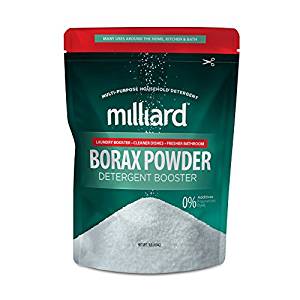
Or, you can opt to mix Borax with powdered sugar. Mix one cup of Borax with three cups of powdered sugar pour the mixture in small containers. Place the containers with sugar and Borax mixture in areas where you have sighted ants and at entry points.
Borax is a slow acting poison meaning that it doesn’t kill the ants instantly when they ingest it. Rather, it takes time to kill the sugar ants, which gives the workers time to carry the sweet poisoned corn syrup back to their colony. Since sugar ants are relentless insects, they will aggressively forage for the Borax poisoned baits, and feed their colonies. Using Borax is one of the most effective ways to eliminate a sugar ants colony.
Boric Acid with Baking Soda
Another effective method of getting rid of sugar ants is mixing boric acid with baking soda which is fatal to these tiny pesky insects. Just like borax, boric acid is poisonous to insects but safe to humans and animals. However, you should exercise caution and use it safely if you have pets and children
You can make boric acid attractive to sugar ants by mixing it with greasy foodstuff, sugary syrup or with powdered sugar. Once you have prepared the boric acid bait, you can spread it on cardboard strips and leave it on places where you have noticed sugar ant’s activity. You can purchase a bottle of 6oz, Sunmark Boric Acid Powder.
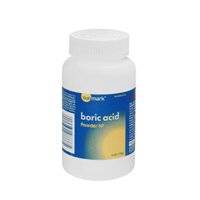
Use Commercial Ant Baits Traps
Commercial ant bait traps work the same way as boric or borax bait traps in eliminating sugar ants. Even though commercial ant bait traps are slow acting poison like borax and boric acid, they kill sugar ants faster than the other two options. They are made with specific food substances that are more attractive to the targeted ant, in this case, sugar ant.
For example, commercial ant baits trap meant for sugar ants will have sugar-based substances, or grease, or protein to appear more attractive to sugar ants. These are substances that are irresistible to sugar ants. A good example of sugar ant bait trap is Terro Liquid ant bait or maxForce Bait Gel.
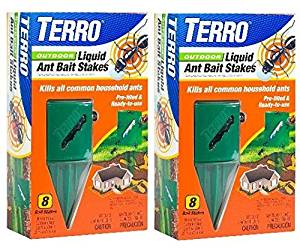
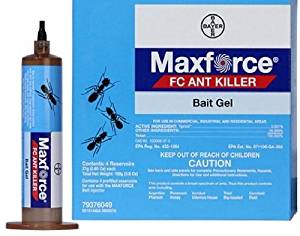
You might have to purchase different commercial ant bait traps and use each on different occasions to know the one that is most effective. You can keep changing the bait traps till you get the one that is attracting the sugar ants most. Also, place the bait traps in areas where there is heavy sugar ant activity.
Additionally, you ensure that there are no competing foods anywhere near the ant bait traps. Presence of other competitive foods may reduce the efficiency of the bait traps, and some ants may not feed on the bait traps at all. After setting the traps, you should start noticing reduced sugar ant activity as days pass by. Do not interrupt the ants once they start feeding on the baits. Let them feast on the baits and carry the poisoned baits back to the rest of their colony.
When using commercial ant bait traps, make sure that you follow the label’s instructions. If the product indicates that you need to wear gloves when handling it, you should do as it says. If it advises on the number of times to use the traps and the amount of bait to use on a single trap, follow the instructions for better results.
Use Sugar Ant Sprays
Commercial ants sprays are not among effective ways of getting rid of ants completely. This is because they only kill the visible ants but do not eliminate the remaining sugar ant population in the nests. However, if you are looking for an immediate ant killing solution, ants sprays can come in handy. You should use ant sprays alongside ant baits.
When purchasing ant sprays, make sure the label indicates that the spray is meant for indoor use. Also, ensure that the indoor space is well ventilated before spraying the killer ant spray. You can purchase Terro Ant killer spray or Orange Guard ants spray.

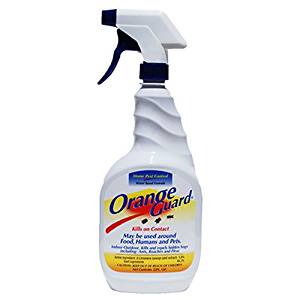
Use Boiling Water On Sugar Ant Nest
Sugar ant nests are much easier to identify. They look like small mounds of dirt with a hole on top. If you want to locate their nests, follow a trail of sugar ants as they carry foodstuff back to their nests. Once you locate the nests, boil salted water and pour the boiling water inside the nest hole. If possible, use as much water as possible to ensure that all the sugar ants are eliminated. The salty water has to be extremely hot, so make sure that you use boiling water.
Ways of Keeping Sugar Ants Away
Keeping sugar ants out of your home is an everyday routine especially during the period when sugar ants are usually active (March to September). One of the places to particularly pay attention to is in the kitchen. This is because your kitchen is the source of all the food that draws sugar ants into your home. Keeping your home clean always will help with sugar ant situation, but it’s not enough for keeping these pesky insects away completely.
Let’s look at some of the effective ways that will help control sugar ants and keep them away from your home.
✓ Seal Entry Points
You need to seal all possible entry points that give sugar ants easy access to your home. If there are cracks in the foundation, on doors, or windows seal them up and spray repellent inside the cracks before sealing them. You need to look around your house, if you come across any decaying frames, shingles or wood, take necessary measures and make replacements and repairs. Ants like to build their nests in decaying wood, and these are the places that they will use to gain access to your home easily.
If the problem is your roof, you can choose to restore it with repairs and painting, but if it’s too old, you should consider replacing it.
✓ Your Sink Should Always Stay Clean and Dry
Sugar ants thrive in dirty sinks. In fact, dirty sinks are their greatest places to get greasy foodstuffs. If you have an infestation, one of the first places to pay close attention to is in your sink. A dirty sink provides enough food and water for these insects.
You should always make sure that your sink is clear of dirty dishes and utensils. Thus, it’s essential to clean dirty utensils and dishes immediately after use. Do not let them stay in the sink for a long period.
Once you clean the dishes, wash the sink thoroughly to get rid of food particles. After cleaning the sink, wipe it using a paper towel to make sure that you get rid of water and moisture and leave it dry. You should also consider pouring a little vinegar or bleach down the sink drain to get rid of any food particles and a rotting smell that is likely to attract sugar ants.
✓ Wipe Your Kitchen Countertops Every Night
Another attractive place for sugar ants other than the sink is dirty countertops. Countertops are food preparation areas, and most of the time you likely leave sugar particle and other spills on the countertop surface. Sometimes you might forget to store your sugar cup after using it and leave it on top of the counter only to find a colony of ants feasting on it the morning.
Therefore, it’s important to wipe your kitchen countertops using bleach every night. You should also wipe other surfaces such as the cabinets, refrigerator top alongside the countertops. Bleach will deodorize and sanitize your counters and get rid of ants trail and the ant’s pheromone trail that ants leave behind for other ants to follow them to their source of food.
✓ Sweep and Wipe Your Kitchen Floor with Bleach
After cleaning your sink and countertop, the next step is to sweep and wipe the floors with bleach. Make sure you sweep your kitchen regularly after every meal preparation, if possible, every evening.
Mop the kitchen floor with bleach and warm water to get rid of ant trails and pheromones. A bucket of warm water is enough to wash away ants and food residuals on the floor. Make sure the floor stays clean and dry every night.
✓ Vacuum You Dining Room Area and Other Spaces Where Food Is Consumed
Dining room and your living room are common places where food is consumed. These are spots in your house likely to have plenty of food scraps such as bread crumbs, sweets, some vegetables, meat, and sugar spills which attracts ants. To avoid attracting ants in your home, you need to regularly vacuum your dining area, and your living room and make sure that the carpet is clean and free of dirt.
Remember, even the smallest of food particle is enough to attract ants that are miles away into your home.
✓ Empty Your Trash Regularly
Leaving garbage in your house for long will not only attract sugar ants but all sorts of pests. To avoid this, you should ensure that you empty your garbage every day. Also, make sure that you use strong garbage bags that cannot easily get punctured and start dripping juices and liquid onto your floors.
✓ Store Foodstuff in Sealed Containers
As mentioned in this guide, ants are relentless in their search for food. They will roam through your kitchen in search of food, and if they come across open boxes of food, they will camp there and feast on it. It’s important to place any opened bagged and boxed food products such as cereals, snacks, cookies, flour, and sugar in tightly sealed containers.
Other food products such as syrups, honey, molasses, should be stored in the refrigerator. When you need to use them, you can gently warm them up.
Professional Cost of Getting Rid of Ants
If the problem of sugar ants in your home persists even after employing all the discussed DIY sugar ants removal methods, you can seek professional assistance to help with the removal. On average, professional ant exterminator charges about $250 for 3000 square feet house on general ants treatment. Labor charges range from $150 to $1000 depending on the type of treatment to be used, repairs, and severity of the infestation.
The professional ant exterminator will assess your home to locate sugar ant’s nests, entry points and find out their source of attraction to your home. The professional will come up with ways to get rid of the ants depending on the size of the infestation.
Here are some of the sugar ant extermination methods used by professionals:
Mound control: also known as dust drill. The exterminator uses special tools to drill into the sugar ants mound and then applies a chemical powder that kills the queen together with the entire colony. Professionals charge about $2 to $3 per mound.
Poisoned baits: the professional sets poisoned bats in various parts of your house especially on entry and exit points. Setting and changing baits can take about seven days. Expect to be charged about $150 for the baits.
Pest treatment: the professional uses general pest sprays around your house including the foundation to kill the ants. An exterminator will charge you an average of $260 for the general pest treatment.
Monthly treatments: depending on the severity of the sugar ant infestation, the exterminator might schedule for monthly treatments to keep controlling the ant’s situation in your home. The initial monthly visit will cost about to80 dollars, and subsequent monthly visits will cost about $30.
| Sugar ants Extermination Services | Average cost |
|---|---|
| General treatment | $250 |
| Cost of sugar ants removal | $250-$100 |
| Mound control | $2-$3 per mound |
| Poisoned baits | $150 |
| Pest treatment | $260 |
| Monthly treatment | $80 ( $30 for subsequent months) |
| Extermination labor charges | $150-$100 |
Conclusion
When sugar ants invade your home, their mere presence can be annoying and frustrating. Sugar ants are some of the most common insects you are likely to find in your home. They can enter your home through various entry points including windows, doors, cracks, and hole in foundation and walls. They will come to your home to forage for food, water and build nests for their colonies.
As the name suggests, sugar ants feed on sweet substances such as sugar crystals, honey, syrup, and nectar. They also feed on food scraps of greasy foodstuffs, meat, breadcrumbs and any leftovers in your kitchen and other food eating areas.
Even though they don’t bite or cause excessive damages like carpenter ants, sugar ants can contaminate your foodstuff such as sugar, meat, cheese, honey, etc. Therefore, it’s important to get rid of them including their nests and colonies. You can use repellents, poisoned baits, boric acid, borax and seal entry points.
In addition to the elimination methods, you need to keep your sinks clean all the time, wipe your countertops and other surfaces, mop and sweep your kitchen floors with bleach, and vacuum areas where food is regularly consumed. If the sugar ant’s infestation persists, you can always seek professional extermination services.
